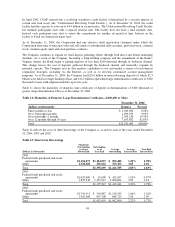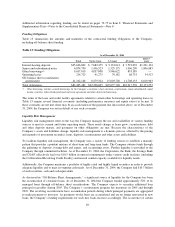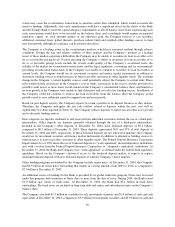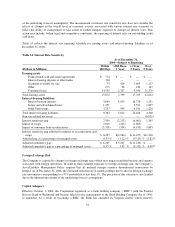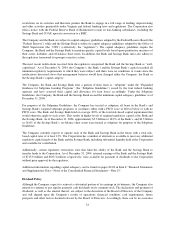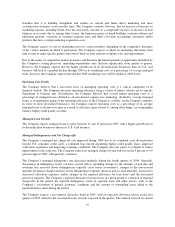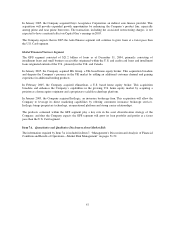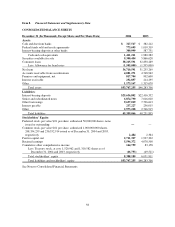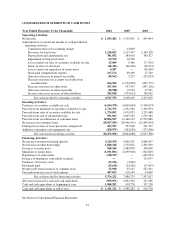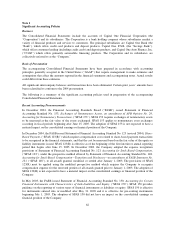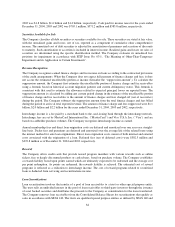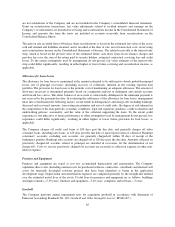Capital One 2004 Annual Report Download - page 78
Download and view the complete annual report
Please find page 78 of the 2004 Capital One annual report below. You can navigate through the pages in the report by either clicking on the pages listed below, or by using the keyword search tool below to find specific information within the annual report.franchise that it is building strengthens and enables its current and future direct marketing and mass
customization strategies across product lines. The Company cautions, however, that an increase or decrease in
marketing expense, including brand, does not necessarily correlate to a comparable increase or decrease in loan
balances or accounts due to, among other factors, the long-term nature of brand building, customer attrition and
utilization patterns, variations in customer response rates and shifts over time in targeting consumers and/or
products that have varying marketing acquisition costs.
The Company expects to vary its marketing across its various products depending on the competitive dynamics
of the various markets in which it participates. The Company expects to adjust its marketing allocations from
time to time to target specific product lines that it believes offer attractive response rates and opportunities.
Due to the nature of competitive market dynamics and therefore the limited periods of opportunity identified by
the Company’s testing processes, marketing expenditures may fluctuate significantly from quarter to quarter.
However, the Company expects that the higher growth rate in its diversification businesses than its U.S. card
business will lead to a gradual decline through 2005 in its marketing costs as a percentage of average managed
loans; however, the Company expects that absolute 2005 marketing costs will be similar to 2004 levels.
Operating Cost Trends
The Company believes that a successful focus on managing operating costs is a critical component of its
financial outlook. The Company measures operating efficiency using a variety of metrics which vary by specific
department or business unit. Nevertheless, the Company believes that overall annual operating costs as a
percentage of managed loans (defined as all non-interest expense less marketing, divided by average managed
loans) is an appropriate gauge of the operating efficiency of the Company as a whole. As the Company continues
its move to more diversified businesses, the Company expects operating costs as a percentage of its average
managed loans to decline over time as a result of efficiency gains related to, among other things, servicing higher
balance, higher credit quality accounts.
Managed Loan Growth
The Company expects managed loans to grow between 12 and 15 percent in 2005, with a higher growth rate in
its diversification businesses than in its U.S. Card business.
Managed Delinquencies and Net Charge-offs
The Company’s managed net charge-off rate improved during 2004 due to its continued asset diversification
beyond U.S. consumer credit cards, a continued bias toward originating higher credit quality loans, improved
collections experience and improving economic conditions. The Company does not expect to continue to realize
improvement at the same rate. The Company expects its managed charge-off rate will stay in the 4 percent to 4.5
percent range in 2005, with quarterly variations.
The Company’s managed delinquency rate decreased modestly during the fourth quarter of 2004. Generally,
fluctuations in delinquency levels can have several effects, including changes in the amounts of past-due and
overlimit fees assessed (lower delinquencies typically cause lower assessments), changes to the non-accrued
amounts for finance charges and fees (lower delinquencies typically decrease non-accrued amounts), increased or
decreased collections expenses, and/or changes in the reported allowance for loan losses and the associated
provision expenses. The Company’s reported allowance for loan losses in a given period is a function of reported
charge-offs in the period, the reported delinquency status of reported loans and other factors, such as the
Company’s assessment of general economic conditions and the amount of outstanding loans added to the
reported balance sheet during the period.
The Company expects a net reported allowance build in 2005, with an expected allowance release in the first
quarter of 2005 related to the seasonal decrease in loans expected in the quarter. The outlook is based on current
55





